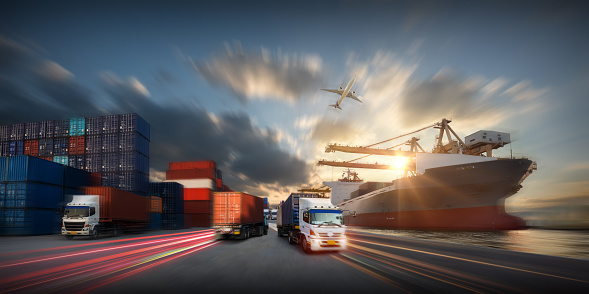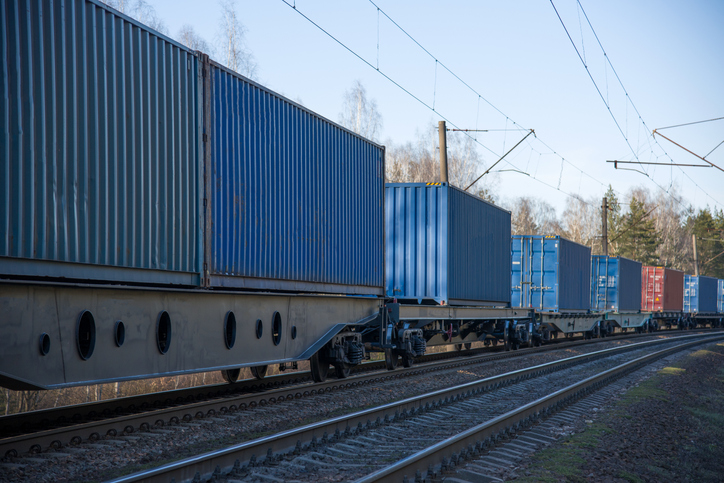In today's complex and interconnected world, intermodal transportation has emerged as a vital component of the global supply chain. Utilizing multiple modes of transportation seamlessly, intermodal transportation allows for the efficient movement of goods across various distances. This comprehensive guide aims to explore the intricacies of intermodal shipping, its benefits, and the different modes it involves.
The Evolution of Intermodal Transportation
Intermodal transportation is a mode of freight transportation that involves the use of different modes, such as rail, truck, and ship, to move freight from the point of origin to the final destination. One of the key elements of intermodal transportation is the intermodal container, which can be easily transferred between different modes of transportation without the need to unload and reload the cargo. This seamless transfer of containers has revolutionized the way goods are transported, allowing for greater efficiency and cost-effectiveness.
Introduction to Intermodal Shipping
Intermodal shipping has become a crucial part of the modern global supply chain, enabling the seamless movement of goods across different distances by leveraging multiple modes of transport. This guide explores the complexities of intermodal transportation, its advantages, and the various modes it encompasses.
History and Evolution of Intermodal Shipping
Intermodal shipping involves utilizing various modes, such as rail, truck, and ship, to transport freight from its origin to the final destination. A cornerstone of intermodal shipping is the intermodal container, which facilitates the smooth transfer of cargo between different modes without the need for unloading and reloading. This innovation has transformed the logistics landscape, enhancing efficiency and cost-effectiveness in freight transportation.
Key Players in the Intermodal Industry
The intermodal industry comprises a range of key players, including intermodal providers, carriers, and logistics firms. These entities play a vital role in facilitating intermodal shipments, ensuring seamless coordination between different modes of transportation to deliver goods efficiently. By leveraging intermodal solutions, companies can optimize their supply chains and reduce transportation costs.
Advantages of Intermodal Shipping
Intermodal Shipping offers a host of benefits, including enhanced flexibility, reduced environmental impact, and increased reliability. By combining multiple modes of transportation, businesses can leverage the strengths of each mode to create a more robust and efficient transportation system. Whether for domestic or international shipments, intermodal transportation provides a versatile and cost-effective solution for moving goods across various distances.
Types of Intermodal Transport
Intermodal transportation encompasses various types of transport modes that work together seamlessly to move goods efficiently across different distances. Let's explore the different modes that make up intermodal shipping and how they contribute to the overall transportation process.
Different Modes of Intermodal Shipping
The different modes of intermodal shipping include rail, truck, ship, and even air in some cases. Each mode plays a significant role in the transportation of goods from the point of origin to the final destination. For example, trucks are often used for short-haul transportation, while trains are more suitable for long-distance transport. By utilizing a combination of these modes, intermodal shipping offers flexibility and efficiency in moving freight.
Example of Ocean Freight in a 40' Container
Consider a shipment that begins as ocean freight in a 40-foot container. This container is loaded onto a ship at the port of origin and transported across the ocean to its destination port. Upon arrival, the 40-foot container is offloaded from the ship and placed onto a train. The train carries the container over long distances, leveraging the efficiency and cost-effectiveness of rail transportation. Once the train reaches its designated rail terminal, the container is transferred to a chassis, a specialized trailer designed to carry containers. A truck then hooks up to the chassis and delivers the container to its final destination, such as a warehouse or distribution center. This combination of ocean, rail, and truck transport showcases the seamless integration and efficiency of intermodal shipping, ensuring goods are moved quickly, safely, and cost-effectively from origin to destination.
Example of a 53' Domestic Rail Container
Another example involves a 53-foot domestic rail container. This container is loaded with goods at a manufacturing plant. It is then transported by truck to an intermodal ramp, where it is loaded onto a train. The train transports the container over a long distance to a different location. Upon arrival at the destination rail terminal, the container is offloaded onto another chassis. A truck then picks up the chassis and delivers the container to its final destination, such as a distribution center or retail facility. This process demonstrates the efficiency and versatility of intermodal shipping, using different transportation modes to optimize the movement of goods across various distances.
Intermodal Containers and Freight Handling
One of the key components of intermodal shipping is the use of standardized intermodal containers. These containers are designed to be easily transferred between different modes of transportation, eliminating the need to unload and reload the cargo. This streamlined process not only saves time but also reduces the risk of damage to the goods during transfer. Efficient freight handling is essential for ensuring the smooth flow of intermodal shipments.
Intermodal containers come in various sizes and types to accommodate different cargo needs. The most common sizes are 20-foot and 40-foot containers, often referred to as TEUs (Twenty-foot Equivalent Units) and FEUs (Forty-foot Equivalent Units), respectively. These containers are used globally and are ideal for a wide range of goods, from electronics to clothing.
Domestically, 48' and 53' rail containers are available for shipping goods. These containers typically are owned by asset-based carriers, railroads or intermodal marketing companies (IMCs).
In addition to standard dry containers, there are several specialized types of intermodal containers:
High Cube Containers: These containers are similar in length and width to standard containers but offer an extra foot in height, providing more volume for cargo that is lightweight but bulky.
Refrigerated Containers (Reefers): These containers are equipped with temperature control systems, making them suitable for transporting perishable goods such as food, pharmaceuticals, and chemicals that require specific temperature conditions.
Open Top Containers: Designed for cargo that cannot be easily loaded through the container doors, open-top containers have a removable roof, allowing goods to be loaded from the top using cranes.
Flat Rack Containers: These containers have collapsible sides and are used for oversized cargo that does not fit into standard containers, such as machinery and vehicles.
Tank Containers: These containers are designed to carry liquids, gases, and powders. They are made of strong materials to ensure safe transportation of hazardous or sensitive liquids.
Insulated Containers: These are used for goods that need to be protected from extreme temperature variations but do not require refrigeration. They maintain a stable internal environment using insulation materials.
Each type of intermodal container is built to withstand the rigors of multiple transportation modes, ensuring that goods are protected and remain intact throughout their journey. The variety of container types allows for the efficient and safe transportation of a wide range of products, contributing to the overall effectiveness and reliability of intermodal shipping.
Intermodal Pricing and Cost Efficiency
Intermodal transportation is known for its cost efficiency compared to traditional shipping methods. By leveraging multiple modes of transportation, companies can optimize their supply chain routes and reduce transportation costs. Intermodal pricing structures are designed to offer competitive rates while maintaining high service levels, making this approach attractive for businesses looking to streamline their logistics operations.
However, the cost efficiency of intermodal transportation depends on several factors:
1. Length of the Trip (Total Miles): The total distance the freight must travel significantly impacts cost efficiency. Intermodal transportation becomes more cost-effective over longer distances, where the savings from using rail or ship over truck transport become more pronounced.
2. Proximity to Intermodal Rail Locations: The cost benefits of intermodal shipping are also influenced by the proximity of the origin and destination locations to intermodal rail terminals. The closer these points are to intermodal facilities, the lower the drayage (short-haul trucking) costs will be. Efficient access to rail terminals reduces the overall transportation expenses and enhances the attractiveness of intermodal solutions.
3. Volume of Freight: Intermodal transportation is particularly beneficial for high-volume shipments. The economies of scale achieved by moving large quantities of goods in standardized containers help spread the cost over more units, reducing the per-unit transportation cost.
4. Type of Cargo: Certain types of cargo, such as non-perishable goods or bulk commodities, are better suited for intermodal transportation. These goods can take advantage of the long-haul cost savings of rail or ship transport without the urgency required for perishable items.
Benefits and Examples of Using Intermodal Transport
Intermodal transportation offers a wide array of benefits that make it a preferred choice for businesses looking to optimize their supply chains and enhance efficiency. By leveraging multiple modes of transportation seamlessly, intermodal transport helps in reducing transportation costs, improving flexibility, and minimizing environmental impact. One of the key advantages of intermodal shipping is its reliability in ensuring goods reach their destination safely and on time.
Case Studies on Successful Intermodal Shipping
Several case studies have highlighted the success of intermodal shipping in various industries. For instance, a leading manufacturing company significantly reduced its transportation costs by utilizing intermodal transport for long-haul shipments, while a retail giant improved supply chain efficiency by integrating intermodal services into its logistics network. These examples demonstrate the practical benefits and positive outcomes of incorporating intermodal transport in business operations.
Comparing Intermodal vs. Traditional Transportation
When comparing intermodal transport with traditional transportation methods, the advantages of the former become evident. Intermodal shipping offers a more flexible and cost-effective solution, especially for long-distance or international shipments. Additionally, the seamless transfer of cargo between different modes of transport in intermodal shipping eliminates the need for multiple handlings, reducing the risk of damage and ensuring smoother operations. These factors make intermodal transportation a preferred choice for businesses seeking efficiency and reliability in their supply chain.
Intermodal Providers and Carriers
Intermodal providers and carriers play a pivotal role in the seamless operation of intermodal transportation. These entities specialize in coordinating different modes of transport, ensuring that goods are moved efficiently from origin to destination. By partnering with reputable intermodal providers and carriers, businesses can benefit from optimized routes, cost-effective solutions, and reliable services. The expertise and resources offered by intermodal providers make them valuable partners in streamlining logistics operations and enhancing the overall supply chain performance.
Call to Action
Looking to move freight efficiently and save money with Intermodal Shipping? Discover how Visigistics can transform your logistics operations with our advanced intermodal transportation solutions. By leveraging multiple modes of transport, we help you optimize your supply chain, reduce costs, and enhance reliability.
Partner with Visigistics to benefit from our expertise, competitive pricing, and seamless integration of intermodal services. Contact us today to learn how we can tailor our solutions to meet your specific needs and drive your business forward. Don’t miss out on the cost savings and efficiency gains—get started with Visigistics now!
Frequently Asked Questions:
Q: What is intermodal transportation?
A: Intermodal transportation is a method of moving freight using multiple modes of transportation, such as rail, truck, and ship, without handling the cargo itself when changing modes. This seamless transfer is made possible by using standardized intermodal containers, which enhance efficiency and reduce the risk of damage.
Q: What are the benefits of intermodal transportation?
A: The benefits of intermodal transportation include cost efficiency, reduced environmental impact, and increased reliability. By combining various modes of transport, intermodal shipping optimizes routes and leverages the strengths of each mode, making it a versatile and effective solution for moving goods.
Q: How does intermodal shipping work?
A: Intermodal shipping involves transporting freight in an intermodal container that can be transferred easily between different modes of transportation, such as rail, truck, and ship. This process ensures that the cargo remains intact from origin to destination, enhancing efficiency and reducing handling times.
Q: Can you provide an example of intermodal transportation in action?
A: An example of intermodal transportation is when goods are shipped from a manufacturer in Asia to a retailer in North America. The cargo is loaded into intermodal containers, transported by ship to a North American port, transferred to a train for long-distance travel, and finally moved by truck to the retailer's distribution center. This seamless process ensures cost-effective and efficient delivery.
Q: What is the history of intermodal transportation?
A: Intermodal transportation has evolved significantly since its inception, with the development of the intermodal container in the mid-20th century revolutionizing freight transport. The use of standardized containers allowed for efficient transfers between different modes of transportation, drastically improving global logistics and supply chain operations.
Q: How can businesses benefit from using intermodal transportation?
A: Businesses can benefit from intermodal transportation by optimizing their supply chains, reducing transportation costs, and enhancing operational efficiency. The flexibility of intermodal shipping allows companies to choose the best modes for different segments of their routes, improving delivery times and reliability.
Q: What is the difference between intermodal and multimodal transportation?
A: The main difference between intermodal and multimodal transportation lies in the handling of cargo. In intermodal transportation, cargo is moved using different modes without being handled during transfers, thanks to the use of intermodal containers. In contrast, multimodal transportation may involve handling and transferring cargo between different modes, often under a single contract or bill of lading.
Q: What types of transportation modes are used in intermodal shipping?
A: Intermodal shipping utilizes multiple transportation modes, including rail, truck, ship, and sometimes air. Each mode plays a crucial role in the intermodal transportation process, contributing to the efficient movement of goods across various distances and through different transportation networks.
Q: How does the intermodal transportation process work?
A: The intermodal transportation process involves transferring goods in standardized intermodal containers between different modes of transportation. These containers are moved from ships to trains to trucks without unloading the cargo, ensuring a smooth and efficient transition that minimizes handling time and risk of damage.
Q: What are intermodal freight containers and why are they important?
A: Intermodal freight containers are standardized containers used in intermodal shipping to transport goods seamlessly across different transportation modes. These containers are crucial because they allow for efficient and secure handling of cargo, reducing the need for unloading and reloading at each transfer point, which enhances overall shipping efficiency.
Q: How can businesses get started with intermodal transportation?
A: Businesses can get started with intermodal transportation by partnering with intermodal service providers and carriers who specialize in coordinating different transportation modes. These providers help businesses plan and execute intermodal shipments, ensuring that the process is smooth and cost-effective from start to finish.
Q: What are the benefits of using an intermodal service provider?
A: Using an intermodal service provider offers several benefits, including access to a broad network of transportation options, expert coordination of multiple transport modes, and optimized routes that reduce costs and improve efficiency. Providers also handle the logistics of transferring intermodal containers, ensuring a seamless and reliable shipping process.
Q: How do intermodal shipments travel across different distances?
A: Intermodal shipments travel across different distances by utilizing a combination of transportation modes best suited for each segment of the journey. For example, long distances might be covered by rail or ship, while shorter hauls are completed by truck, ensuring the most efficient and cost-effective transportation for each part of the route.
Q: What role does rail intermodal play in the transportation network?
A: Rail intermodal plays a significant role in the transportation network by providing a cost-effective and environmentally friendly option for long-distance freight transport. Railroads can move large volumes of intermodal containers efficiently, reducing highway congestion and lowering transportation costs compared to over-the-road trucking for long hauls.
Q: How can companies benefit from domestic intermodal shipping?
A: Companies can benefit from domestic intermodal shipping by leveraging the efficiency and cost savings of using multiple transportation modes within the country. This approach allows businesses to optimize their supply chain, reduce transportation costs, and improve delivery times while minimizing their environmental footprint.
Q: What is the difference between domestic intermodal and international intermodal shipping?
A: Domestic intermodal shipping involves transporting goods within the same country using multiple transportation modes, whereas international intermodal shipping crosses national borders. Both types use standardized intermodal containers to facilitate smooth transfers between modes, but international intermodal shipping also requires compliance with customs regulations and international logistics coordination.





